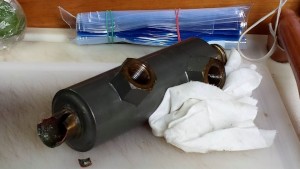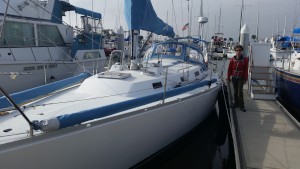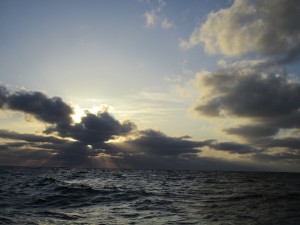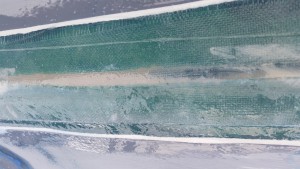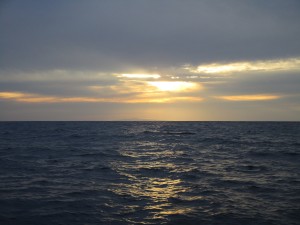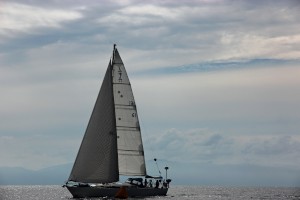S/V Northern Lights
| Vessel Name: | Northern Lights |
| Vessel Make/Model: | J/42 - #61 |
| Hailing Port: | Seattle |
| Crew: | Rod and Mary Deyo |
27 June 2015
Yanmar engine repairs - Replacing the oil cooler
Before heading to Chula Vista where we left the boat for the summer, we spent a couple of days anchored in Glorietta Bay as a nice break after working on the boat. While inspecting the engine before leaving Shelter Cove Marian, I had noticed a slight seepage around the oil cooler raw water intake at [...]
23 June 2015
San Diego - Shelter Island, Glorietta Bay, Chula Vista
After finishing the Baja Bash, we stayed at Shelter Island to work on the boat and haul-out at Driscoll's. We made a coouple of trips to Glorietta Bay in Coronado for a total of five nights. Before we headed back to the NW, we took the boat to Chula Vista where it will be moored for the summer.
29 May 2015
Mazatlan to San Diego – Southern Crossing and Baja Bash 7 May – 26 May 2015
Mazatlan to San Diego - Southern Crossing and Baja Bash 7 May - 26 May 2015.
25 April 2015 | Mazatlan, Sinola, Mexico
Fixing a leaky hull seam in Mazatlan
Hull seam repairs on Northern Lights being done in Mazatlan, where the seam area forward of the keel was the source of the small, persistent mast step leak from flaws in the filler. The original seam filler is being ground out, the area dried, then it will be epoxied and covered with two layers of glass [...]
Cruising Stuff: Radios
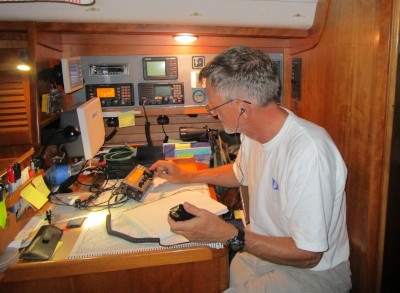
Our radio systems and resources included:
ICOM IC-604 Marine VHF
ICOM IC-802 Marine SSB
ICOM AT-140 Antenna tuner
Elecraft KX3 160-6m all mode transceiver
Elecraft KXPA100 amplifier with KXAT100 antenna tuner
Yaesu VX-6R Hand-held wide-band transceiver
Standard Horizon HX851L hand-held VHF (2)
Standard Horizon HX480 hand-held VHF
ICOM IC-M73 hand-held VHF
MFJ "Big Stick" 17' whip antenna
Shakespeare VHF antenna
Pactor DR-7800 "P4 Dragon" modem with Bluetooth
We have a ship's station license (WDF5444) and restricted radiotelephone licenses for both Mary and I. I also have an amateur Extra ham license (KF7UXC) and operate as a "maritime mobile" when on Northern Lights (see my QRZ page KF7UXC ).
Northern Lights has an integral backstay HF antenna with Navtec insulators on the rod rigging, along with stand-off insulators for the GTO-15 antenna feed and a copper grounding mesh glassed into the aft hull. The Shakespeare VHF antenna is at the top of the mast and is shared with the Class B AIS transponder through an antenna coupler.
GPS position information for DSC is sent to both the IC-604 and IC-802 using NMEA0183. The IC-802 uses a long-wire antenna run along the cable run as the dedicated HF DSC listening antenna, but this is not a very effective approach. The alternative of mounting a permanent HF whip antenna on the stern is not attractive.
A ham radio sitting on the chart table can be connected to the HF backstay antenna through an antenna switch and can either use the AT-140 or bypass it and use its own tuner. I also occasionally use a 17 ft "Big Stick" whip antenna with the KX3 that can be tuned for 40-10m without an antenna tuner by adjusting its coil taps. It makes a great emergency SSB backup antenna.
Fair-rite Type 31 RF chokes are installed at the IC-802 transmitter and Pactor modem for the radio control, audio signal, PC USB cable, and coax antenna cable connections. A RadioWavz B11 ISO 1:1 Current Isolation inline choke was also installed on the coax to the AT-140, but was eventually removed as unneeded.
The Pactor DR-7800 Bluetooth PC connection was tried for a while, but found to be unreliable and a USB connection used instead. The USB cable to the computer on the chart table works very well and eliminated dropped radio control connections while in the middle of Sailmail sessions.
We use both Sailmail and Winlink for HF email. Both have worked well from Cape Scott to Banderas Bay by choosing an appropriate band for the best propagation based on time-of-day and the least QRM/QRN. The Pactor protocols are error correcting, but will reduce the bit rate if too many errors are encountered during transmission. Ideally, the usual Sailmail Pactor 3 protocols will run at 3600 bps, which make for much speedier download of larger weather data and GRIB files.
While were were in harbor at La Paz, Puerto Escondido, Mazatlan, and Banderas Bay, we listened to the VHF nets in the morning (usually 0800/0830 local time). The VHF nets have been very useful sources of information and "local assistance" for cruisers.
When underway, we often checked into the Marine SSB or Ham nets when propagation conditions allowed (while in Mexico, mainly these were the Sunrisa, Amigo, Chubasco, and (rarely) Pacific Seafarers nets). When we were up north in Canada or along the west coast, at least one or more SSB nets was open, but once we got to the Sea of Cortez and closer to the tropics, the morning 80m and 40m bands were often not usable because of static noise. Instead, we've found that Sailmail using the Pactor modem with its choice of transmission band, digital error correction, and reliable protocols has been much more effective for downloading transcriptions of the daily Sunrisa weather summaries (Sunrisa Sailmail WX Docs). as well as the latest GRIB files and messages.
Salt water is a really fabulous ground plane conductor and the slanted vertical backstay antenna over it makes for great DXing - at least when in low RF noise anchorages (Isla San Francisco was particularly good with less than S1 ambient noise on 20m). I've been able to contact hams in the Indian Ocean, S. Pacific, and West Africa during the trip. Unfortunately, most marinas on the west coast have been very RF noisy with boat refrigeration, air conditioning, and inverters, along with shore-side transformers and sparking AC systems, etc.
